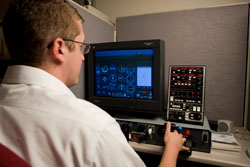 On Jan. 25, Bob Knill, an instrument-rated private pilot in Frederick, Md., flew 1.9 hours of IFR practice “under the hood” in a rented Piper Warrior and logged three ILS approaches and unusual attitude recoveries with a CFII.
On Jan. 25, Bob Knill, an instrument-rated private pilot in Frederick, Md., flew 1.9 hours of IFR practice “under the hood” in a rented Piper Warrior and logged three ILS approaches and unusual attitude recoveries with a CFII.
His cost, including aircraft rental, fuel, and instructor fees, was about $300.
On Tuesday, Knill performed several more approaches with his instructor—with emergencies such as a simulated vacuum pump failure and pitot ice thrown in—during 90 minutes in a personal computer-based aviation training device (PCATD).
His cost (since he had free access to the PCATD) was zero.
All six of the approaches, as well as the holds and tracking radials, could be logged for Knill’s IFR proficiency. Afterward, he said the real airplane and the simulator have certain advantages.
“The unusual attitude recoveries in the airplane were great because there’s no other way to simulate those sensations without actual movement,” he said. “The system failures in the simulator were helpful because you can’t re-create them in the airplane. It’s different seeing the airspeed indicator at zero (as it would be if the pitot tube entrance were blocked by ice) than simply covering up the airspeed indicator.”
Airline and military flight training pioneered the use of sophisticated simulators in the last 25 years, and general aviation is following with computer-based, high-fidelity systems.
In order to qualify as a PCATD, a computer system must have physical controls attached, and manufacturers must gain approval for each model. The FAA requires that PCATD flight controls respond with the same immediacy, and in the same way, as an actual airplane. As computers have gained processing power, and graphics and software have rapidly improved, flight simulator performance has become increasingly realistic.
All PCATDs must have a self-centering control stick or yoke, rudder pedals, and physical controls (not a computer mouse) for moving flaps, throttle, propeller RPM, mixture, pitch trim, communications and navigation radios, timers, landing gear levers, and other cockpit controls and instrumentation.
PCATDs are increasingly being incorporated into flight schools, and instrument students can log up to 10 hours—half their allowable simulated IFR time—on the devices.
Student pilots can log up to 2.5 hours of simulator time toward private pilot certificates, and commercial students can log up to 50 hours. Without fuel, mechanical wear and tear, or insurance costs, flight simulators typically cost about one-third as much to rent as real airplanes. And some students buy them outright for training at home.
Instead of a noisy, stressful environment, simulators allow pilots to hit the “pause” button any time they have a question or want to see something play out again. And before going on a cross-country trip to an unfamiliar airport, pilots with access to PCATDs can build familiarity and confidence by flying all the approaches they might get before they ever leave town.
For more information about PCATDs and logging simulator time, see the AOPA Pilot Information Center’s subject report, or call the experts in AOPA's Pilot Information Center at 800/872-2672.



